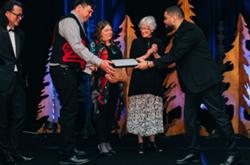In late 2023, the federal government, British Columbia and the First Nations Leadership Council signed a $1 billion Nature Agreement to protect 30 per cent of B.C.’s lands by 2030.
The agreement stressed the full collaboration of Indigenous Peoples in alignment with the United Nations Declaration on the Rights of Indigenous Peoples.
The Nature Agreement follows a series of historic federal investments in nature conservation over the past several years. Like the previous announcements, the 2023 Nature Agreement includes funding for Indigenous Protected and Conserved Areas, or IPCAs.
Environment Minister Steven Guilbeault stated about the agreement:
I think people will look at this agreement and say, "OK, this is how it needs to be done going forward now in Canada."... It’s nature, it’s conservation, it’s restoration, but it’s also about reconciliation.
However, despite advances in Canadian conservation policy and practice, our research has shown that First Nations advancing IPCAs can still face significant challenges.
Unless Canadian governments meaningfully address these challenges, the reconciliatory potential of IPCAs — and new funding agreements intended to support them — will be undermined.
Indigenous Protected and Conserved Areas
IPCAs present vast opportunities for nature conservation and reconciliation. However, they also face multiple pressures. Unlike regular parks and protected areas in Canada, IPCAs are established and maintained by First Nations, Métis and Inuit governments.
Indigenous governments establish IPCAs under their own Indigenous laws, while some also choose to pursue protection under Canadian law.
IPCAs are varied but typically support ecological restoration or protection and local economic development while centring Indigenous cultures, languages, knowledge and laws. At the heart of IPCAs is Indigenous governance over lands and waters for future generations.
The Indigenous-led conservation movement in Canada is gaining momentum along with growing awareness of how wilderness conservation has disenfranchised Indigenous Peoples through displacement, criminalization and limiting access.
Simultaneously, efforts to advance reconciliation in Canada and recognize inherent Indigenous rights are more widespread.
While a few First Nations in B.C. established the first tribal parks in the early 1980s, IPCAs have been emerging across the country since 2018, some with support from federal funding programs.
In 2018, the Indigenous Circle of Experts, a national Indigenous-led advisory group, advocated for IPCAs as a solution for Canada to achieve its nature conservation targets while advancing reconciliation with Indigenous Peoples.
Since 2018, Environment and Climate Change Canada has funded 59 Indigenous-led conservation proposals and a First Nations National Guardians Network.
Roadblocks to reconciliation
One of the biggest challenges for IPCAs is the pressure of resource extraction. Even once an IPCA is declared, it may not be safe from resource extraction, as was the case with Dasiqox Nexwagwezʔan, an IPCA in B.C.
Canadian governments continue to grant tenures and licences to companies for logging, mining, fish farms and other impactful activities inside IPCAs against the wishes of Indigenous nations.
These actions go against the United Nations Declaration on the Rights of Indigenous Peoples and its foundational principle of free, prior and informed consent. Canada and B.C. have both implemented legislation on the declaration.
This dynamic is not surprising since many Indigenous nations establish IPCAs precisely because Canadian governments do not respect their governance and decision-making authority around extractive industry.
Indigenous governments are sometimes forced to compensate companies by buying out tenures to ensure protection of their IPCAs.
While there are examples of tenure buyouts that enabled Indigenous nations to establish IPCAs, these are extremely costly and impractical and should not be considered the norm.
Another option is for “cooling-off periods” that pause resource extraction while IPCA planning and negotiations are underway.
These challenges are particularly acute in instances where IPCAs are not designated under Canadian protected area legislation. The vast majority of Canadian governments have not created new legislation or amended existing legislation to explicitly enable the designation and protection of IPCAs.
This means that Indigenous governments seeking additional legal protection for their IPCAs must make do with regular protected area designations that limit Indigenous authority, even under co-management arrangements.
Indigenous governments establishing IPCAs also face financial struggles. Previous federal investments in Indigenous-led conservation revealed high demand for funds but resulted in only a small percentage of projects getting funding, sometimes due to IPCA visions clashing with resource extraction aims.
A further issue is that funding is only for IPCA establishment and not ongoing stewardship.
At the core of these challenges are fundamental conflicts regarding the Crown’s continued assertion of its ultimate authority. This assertion is in spite of the Canadian government’s own guidance for reconciliation and legal pluralism — including the recognition of Indigenous rights and building equal relationships with Indigenous Peoples.
Systemic change will advance reconciliation
Canadian governments increasingly view IPCAs as a means of meeting their conservation targets under the Convention on Biological Diversity — especially the goal of protecting 30 per cent of Canada’s lands and waters by 2030. This requires roughly doubling the total protected area in Canada.
At the recent COP28 climate conference, parties underscored the need to take action on biodiversity loss, climate change and land degradation in a “coherent, synergetic and holistic manner.” This includes cutting global greenhouse gas emissions by 43 per cent, compared with 2019, by 2030 in order to keep global warming under 1.5 C.
While the most recent conservation funding announcement is commendable, it is unclear how the $500 million of new federal funding, which includes previously announced funds, will be distributed. Additionally, internal government records allegedly show that B.C. may use the agreement to avoid federal efforts to protect species at risk in the province.
The challenges IPCAs surface can be embraced as catalysts for reconciliation. This involves changing mindsets, behaviours, practices, policies and laws at multiple scales. It is the kind of transformative work that the Truth and Reconciliation Commission called for in all sectors of society.
IPCAs offer tremendous potential for addressing the biodiversity and climate crises and repairing relationships with Indigenous Peoples.
As such, how Canadian governments and the conservation sector respond to the roadblocks encountered by Indigenous governments advancing IPCAs is crucial. Only by assisting these initiatives can we build meaningful and lasting IPCAs that not only restore and protect ecosystems but also advance reconciliation through Indigenous governance, laws and knowledge systems.![]()
![]()
Read more: Indigenous, Federal Politics, Environment















Tyee Commenting Guidelines
Comments that violate guidelines risk being deleted, and violations may result in a temporary or permanent user ban. Maintain the spirit of good conversation to stay in the discussion and be patient with moderators. Comments are reviewed regularly but not in real time.
Do:
Do not: